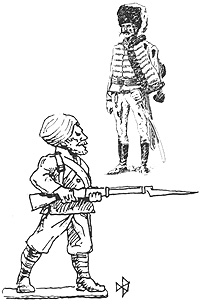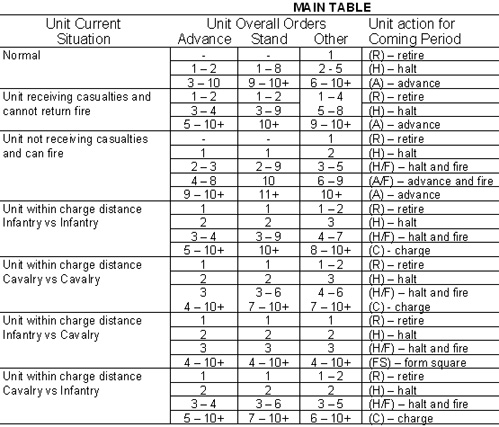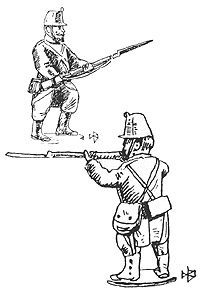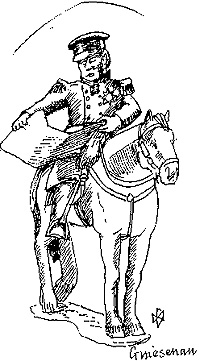 How many times has your favourite wargame unit opened fire at the most decisive point and how many times, as if by divine guidance have they advanced, charged or retired at the most opportune moment?
How many times has your favourite wargame unit opened fire at the most decisive point and how many times, as if by divine guidance have they advanced, charged or retired at the most opportune moment?
No matter how impartial we try to remain, it is almost impossible for us not to let our personal preferences and our “see all, hear all, God like existence”, sway our decisions regarding unit actions. To see your favourite infantry unit caught in total disorder by opposing cavalry is almost heart breaking.
So how many times are the rules criticised, re-analysed and in some cases re-written, all to allow the infantry unit time to prepare. Likewise, opposing enemy units currently without orders, how often have they stood and watched golden opportunities pass them by due to your reluctance to bring them into action and so destroy your overall game plan?
These problems, and many others like them, have bothered me for years. I found that the throwing of a dice for every separate occasion only led to other problems, such as when to throw the dice and what limits to set. I always found myself altering the limits to suit the result I required. For instance, the small chance of success for the cavalry to charge my unformed infantry heroes.
 To counter this I drew up the following table. The theory behind it being that each wargame unit, just as in real life, is given its overall battle orders from the Commander-in-Chief. It is then up to the officers in direct command of that unit to ensure that the objectives are achieved.
To counter this I drew up the following table. The theory behind it being that each wargame unit, just as in real life, is given its overall battle orders from the Commander-in-Chief. It is then up to the officers in direct command of that unit to ensure that the objectives are achieved.
Therefore use of the table will hopefully take some of the control of the wargame units away from you, thereby giving a more realistic feel to the game. No longer will you be able to have any say or dealings in the units actions. Just sit back and watch chaos develop.
Of course, if the C-in-C is in direct contact with the unit, the unit will be able to act exactly as required. Although this still does not mean the unit can react to unseen enemy actions!
To use the table, simply cross-reference the unit’s current situation, as listed down the left side, with its overall orders marked across the top. This will indicate a series of numbers between 1 – 10. Throw 1D10 dice and add or subtract any of the adjustments which relate and transfer this total across to the right hand side of the table where it will indicate the actions the unit will make during the next gaming period. This procedure is carried out for every unit on the table.
The system appears very slow and complicated but with a little perseverance and practice the results come out quite quickly.
For instance,
 EXAMPLE 1.
EXAMPLE 1.
An infantry unit with general orders to advance comes under long range artillery fire. For the coming period, its current situation is a “UNIT IS RECEIVING CASUALTIES AND CANNOT RETURN FIRE”. A 1d10 thrown, scoring 3, add 1 for unit currently advancing, result 4. this, when looked up on the table gives HALT, therefore the unit will remain where it is for the next period.
EXAMPLE 2.
An opposing, stationary troop of horse artillery currently without orders is presented with a target, your finest cavalry. Its current situation is “UNIT IS NOT RECEIVING CASUALTIES AND CAN FIRE”. A 1D10 is thrown, score 6, less 1 for unit halted last move, result 5. Therefore the artillery will remain where they are and commence firing at your cavalry in the coming period.
EXAMPLE 3.
Your infantry unit having regained its forward motion, after being joined by its eager for action commanding officer, now find themselves under fire from an artillery unit to their front. Their current situation is “UNIT IS RECEIVING CASUALTIES AND CAN RETURN FIRE”. A 1D10 is thrown, score 8, add 1 for unit advancing plus another 1 for keen leadership, result 10, and giving advance. Therefore the unit will press on regardless of the enemy fire eager to join in hand to hand combat.
 Of course this system does not cover all eventualities. If further dice rolls are required ensure that all the possible options are written down before the dice is thrown and whatever the outcome, stand by it!
Of course this system does not cover all eventualities. If further dice rolls are required ensure that all the possible options are written down before the dice is thrown and whatever the outcome, stand by it!
The actions given in the table obviously do not override compulsory morale reactions, such as fall back or rout. The table only gives a list of actions that would normally be selected by yourself.
To keep track of all the unit actions I use a series of small square pieces of card each marked with an abbreviation from the table. These are placed behind the unit so I have a constant reminder of what each unit is doing, if I am called away. I know exactly what is happening when I return. I use this system with the Crimean period of warfare and therefore it should be directly compatible for other periods such as Napoleonics.
-
Adjustments
Adjustment Description
-1 Unit halted last period
-1 Unit has poor leadership
-2 Unit retired last period
+1 Unit advanced last period
+1 Unit has good leadership
Back to Table of Contents -- Lone Warrior # 147
Back to Lone Warrior List of Issues
Back to MagWeb Magazine List
© Copyright 2004 by Solo Wargamers Association.
This article appears in MagWeb.com (Magazine Web) on the Internet World Wide Web.
Other articles from military history and related magazines are available at http://www.magweb.com
